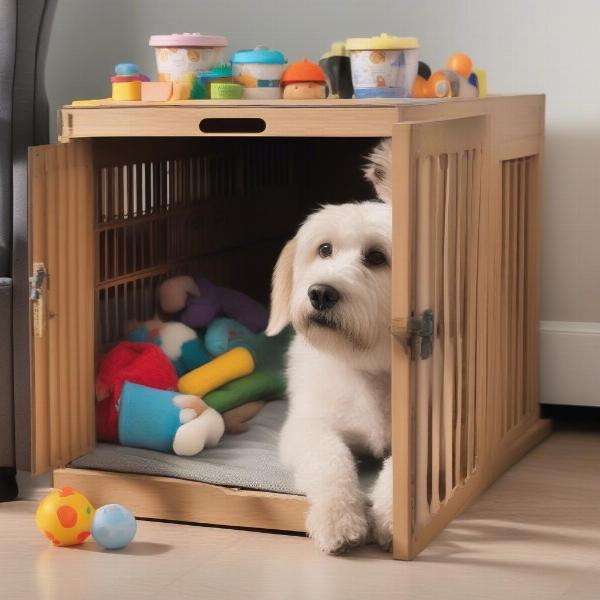Crate training can be a highly effective method for raising a well-adjusted and happy dog. Whether you have a new puppy or an older dog, a crate can offer a safe haven, aid in housetraining, and prevent destructive behaviors. This guide will delve into the world of crate training for dogs, covering everything from choosing the right crate to addressing common challenges.
Choosing the Right Crate for Your Dog
The first step in crate training is selecting the appropriate crate. There are various types available, including wire crates, plastic crates, and cloth crate for dogs. The size is crucial. Your dog should be able to stand, turn around, and lie down comfortably. A crate that’s too large can hinder housetraining, while one that’s too small will be uncomfortable and restrictive.
Consider your dog’s breed, size, and anticipated adult size. For puppies, choose a crate with dividers to adjust the space as they grow. This prevents them from using one end as a bathroom and the other for sleeping.
Introducing Your Dog to the Crate
Introducing the crate should be a positive and gradual process. Start by placing the crate in a familiar area of your home, such as the living room. Make it inviting by adding soft bedding, toys, and treats. Leave the door open and allow your dog to explore at their own pace. Encourage them to enter by tossing treats inside.
 Introducing a Dog to its Crate
Introducing a Dog to its Crate
Never force your dog into the crate. This can create negative associations. Patience and positive reinforcement are key. Once your dog is comfortable entering and spending short periods in the crate with the door open, you can begin closing the door for short intervals.
Using the Crate for Housetraining
Crates are invaluable for housetraining. Dogs instinctively avoid soiling their den. By confining your dog to the crate when you cannot supervise them, you can minimize accidents and reinforce proper potty habits. Take your dog outside immediately after letting them out of the crate. Reward them with praise and a treat when they eliminate outdoors.
Addressing Common Crate Training Challenges
Some dogs may whine or bark when first introduced to the crate. This is often due to anxiety or separation distress. It’s crucial to avoid letting them out while they’re whining, as this reinforces the behavior. Instead, wait for a quiet moment before opening the door. If your dog exhibits excessive anxiety or destructive behaviors in the crate, consult with a certified dog trainer or veterinarian. They can help identify the underlying cause and develop a tailored training plan.
Crate Training an Adult Dog
While crate training is often associated with puppies, it can also be beneficial for adult dogs. travel crate for dogs can be especially useful. Follow the same gradual introduction process as with puppies. Be patient and understanding, as it may take longer for an adult dog to adjust to the crate.
What Size Crate Do I Need for My Dog?
The size of the crate should allow your dog to stand up, turn around, and lie down comfortably.
How Long Can I Leave My Dog in a Crate?
The duration depends on your dog’s age and individual needs. Puppies should not be crated for extended periods.
Can I Use the Crate as Punishment?
No, the crate should be a safe and positive space, never a place of punishment.
What if My Dog Continues to Whine in the Crate?
Avoid releasing your dog while they are whining. Wait for a quiet moment and offer positive reinforcement.
Are There Different Types of Crates?
Yes, common types include wire, plastic, and folding crate for dogs.
Conclusion
Crate training, when done correctly, can be a valuable tool for dog owners. It provides a safe haven for your dog, assists in housetraining, and can prevent destructive behaviors. By choosing the right crate, introducing it gradually, and addressing any challenges patiently, you can make crate training a positive experience for both you and your furry friend. Remember that consistency and positive reinforcement are key to success. dog crate for dogs can be a great investment.
ILM Dog is your go-to resource for expert advice on all aspects of dog care, from breed selection to health and training. We offer a wealth of information to help you navigate the journey of dog ownership. Whether you’re a seasoned dog owner or just starting out, we’re here to support you. Contact us at [email protected] or call us at +44 20-3965-8624. Visit ILM Dog for more helpful resources.